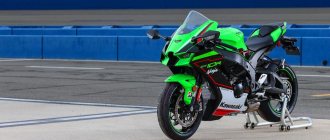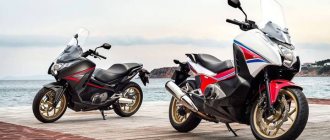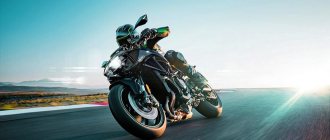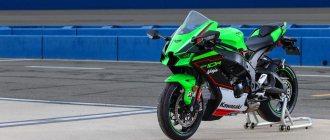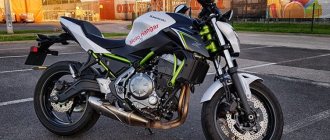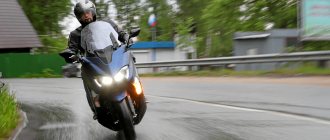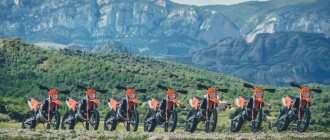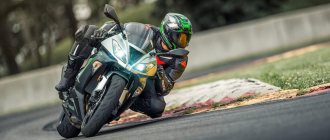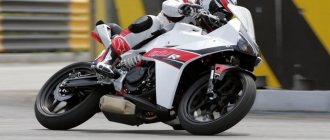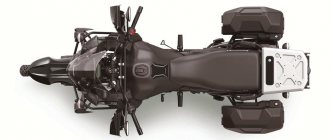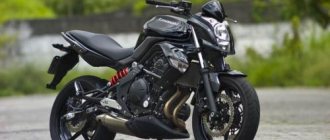Kawasaki Ninja 400 delivers more punch, less weight and a new feel
The new Kawasaki Ninja 400 has a big task ahead of it. Not because it evokes memories of the evil 400s of the early 90s, which, by the way, it copes with thanks to Euro 4, but also because of the previous, excellent Ninja 300, which needs to be surpassed. The new product from Kawasaki is designed to serve as an entry ticket to the world of motorcycle racing with power, flexibility and various bells and whistles.
Test drive: Kawasaki Ninja 400 2018
On paper, everything is fine: more power (+5 hp), less weight (-6.6 kg). Plus, it has a fantastic appearance, partly borrowed from: aggression in design, “shark nose”, sophisticated tail.
Although this is an entry-level racing sportbike, the riding position is a bit conservative, with the pegs set further forward than you might expect. The clip-ons, although now located lower, are still located above the usual level of clip-ons on such equipment. The low 785 mm saddle was left untouched, which, by the way, is good news for short and novice riders. The result is a neutral landing with good visibility and comfort, as far as this word is applicable here.
399cc Kawasaki Ninja engine
But what's really important about the new Kawasaki Ninja is its new 399cc engine, which is the reason the motorcycle was created. Along with the new cubic centimeters comes an increase in power - 44.3 hp. and 28 moments (versus 39 and 19, respectively).
The bike feels great at 6,000 rpm, but push it past 10,000 rpm and the power, excitement and rich exhaust note will leave you grinning.
Naturally, there is no such power here that would make the motorcycle fly out of your hands. But driving at rpms above 7000 brings a lot of emotions. The power is delivered in sufficient quantities for overtaking and comfortable driving on highways at high speed limits. Also, despite the fact that the engine is very rigidly attached to the frame, the vibration from it is so small that sometimes you want to rev the throttle just to check if the motorcycle is working at all.
Since the cubic capacity is low, the gearbox clicks constantly. The updated gearbox is good, and the slipper clutch makes life easier on gear drops.
Kawasaki Ninja 400 suspension
Although the Kawasaki Ninja 400 suspension is non-adjustable (with the exception of rear preload) , this is not particularly scary, since the adjustment comes from the factory.
The fork has become fatter from 37mm to 41mm and feels great in city driving. The bike's excellent overall balance is achieved through a new tubular frame that is closely intertwined with the engine, as well as a swingarm integrated directly into the same frame. No extra weight, the design is somewhat similar to the flagship Ninja H2.
After several hours of testing
At first glance, both motorcycles are similar, they are both equipped with ABS as stock, but in fact there is a very noticeable difference between them. The Yamaha YZF-R3 is a lightweight racer with a composed chassis and nimble steering that encourages aggressive riding, but its smaller displacement puts it just behind the Kawasaki Ninja 400. Put 2-3 R3s on the track and you'll get a great race and a great experience.
Should we expect an R4 with a slightly larger cubic capacity? Or for those who need more cubes, are there already 500 and 600 cc sportbikes? Or even just a liter?
After several hours of testing on these two bikes, we think 400cc is just right. The Kawasaki Ninja 400 engine is the perfect balance of power, torque and character, giving beginners controllability and serious guys serious fun. The Ninja's chassis has a couple of slight shortcomings on the track when compared to the scalpel-sharp Yamaha YZF-R3, but in return the Kawasaki offers more comfort on the road. And its chassis performs more than decently in the real world.
Brakes Kawasaki Ninja 400
The Kawasaki Ninja 400 brakes have also been updated. New Nissin caliper, new, stiffer brake machine with a 20mm cylinder, larger single brake disc (as if removed from the ZZR1400). All this together has a braking force that stops the motorcycle even when you lightly press the lever. At the same time, the lever retains its information content and allows you to evaluate light alloy wheels. The rear brake is as effective as required. The model is equipped with ABS.
Comparison of Yamaha YZF-R3 and Kawasaki Ninja 400 sport bikes
Of course, huge herds and tight wallets are very cool, but this is far from the main thing when it comes to sportbikes: the Kawasaki Ninja 400 and Yamaha YZF-R3 are proof of this. These two bikes can handle like an adult, but won't kill a newbie unless they try hard enough. Relatively low seats, friendly (if thrilling) power, easy handling and reasonable prices attract new users. But even experienced motorcyclists will be pleased with these bikes, because you can ride them quickly, without compromising the comfort of everyday use. Moreover, this class of sport bikes is available to riders of any skill level, even zero. Don't believe me? Our test team consisted of both professional racers and urban motorcyclists, and we collected opinions from a wide variety of people with different personalities and skills. And these people talked about them with a smile.
Small-capacity sports have their advantages
Liter sportbikes undoubtedly have a lot of advantages, but small-capacity sports also have their advantages. For example? For example, power that won’t knock you over if you use the wrong cornering technique. At the same time, there is enough power for fast driving, but you will show truly good time on the track when you hone your technique: precise steering, timely entry into turns, the ability to control traction and inertia. Small-capacity sportbikes allow you to see a mistake in its infancy and prevent it from becoming a habit, while the consequences of the mistake are unlikely to become severe.
These two motorcycles are leaders in their class, and they perform quite well on the track, especially in capable hands. Despite this, many people use them as road bikes, and this is understandable: light sportbikes make up about 40% of sales of all supersports, and most of them are purchased by first-season beginners.
Kawasaki Ninja 400
The 2021 Kawasaki Ninja 400 is rightfully considered one of the best lightweight road bikes (in the broadest sense), and in fact it sets the bar in the small supersport segment. The success of the 250 and 300 cc models prompted the green manufacturer to release a 400 cc inline-two and install it in an updated steel tubular frame. The new engine turned out to be even more successful, bringing the lightweight Ninja to the top sales positions in the Kawasaki lineup.
Yamaha YZF-R3
In response, Yamaha updated the YZF-R3 in 2021, introducing visual and aerodynamic improvements that made it 7% more streamlined and raised the top speed by 8 km/h, which is quite a lot in the small-capacity class. In-line two with a volume of 321 cubic meters. cm remained unchanged, but the bike received a 37-mm inverted KYB fork, which replaced the usual 41 mm, as well as an LCD instrument panel and more aggressive ergonomics. Yamaha says it has sold more than 20,000 YZF-R3s over the past three years, accounting for roughly half of all R-series sales.
Comparison of sportbikes
Yes, we have already said that for many owners these motorcycles are just transport, road workers... but look at them more closely. Echoes of World Superbike and MotoGP are visible throughout their body kits, not to mention the promotional photos of these bikes posing on the track. So we decided to compare them on a real race track.
The track consists of 17 turns, relatively short straights, hard acceleration sections and significant elevation changes, all of which allowed us to put these bikes to the test. But before we brought them to the track, we weighed them, measured them and ran them on the dyno. And then we put them both in Dunlop Sportmax Q3+ in order to put them in the same conditions for grip.
Looking at the dyno graph makes it clear what the extra 78cc Ninja 400 is worth. The Kawasaki produces 43.4 hp. at 9900 rpm and 33.5 Nm at 8300 rpm. The Yamaha YZF-R3, in turn, produced 36 hp. at 10,700 and 26.9 Nm of thrust at 9,000 rpm. A closer look will reveal that the R3's thrust curve is much flatter than the Kawasaki's, and the power drops off more noticeably as it reaches redline. A flat and smooth curve is a sign of a high-torque character, but the dip at the end forces you to ride the Yamaha in a narrow rev range and shift as quickly as possible in order to always remain at the working torque. At the same time, the Ninja's torque curve is steeper in the midrange and it lingers longer past peak, allowing for subtle revs and more flexible shifting.
Unsurprisingly, the Kawasaki feels like a rocket, delivering 13 km/h more on the straights. Open throttle instantly revs the engine to 7500, powerfully pulling out of slow corners and leaving the R3 behind. Additional traction at the bottom makes it easier to cope with mistakes, gaining speed faster after overbraking. Ask any of our testers and they'll tell you that the extra 24% power makes a big difference on the track, making the Ninja not only faster, but more fun, too.
As a result, simply because of the smaller cubic capacity, gear selection and torque retention are critically important on the Yamaha YZF-R3: the Yamaha does not move at all up to 9000 rpm. The live sensations correspond to the schedule from the dyno, that is, it starts to drive only on a well-spun engine. This does not make it definitely worse, because in terms of cornering at speed, it allows the rider to progress faster, and the chassis and brakes are quite consistent with a more sporty character. But putting 321 cubes against 400, you get a disappointing lag in speed.
Excellent feedback from the Yamaha YZF-R3's front suspension compensates for the loss of feel when cornering, even though the lack of a slipper clutch prevents the model from unleashing its true potential. Without a perfectly smooth release of the clutch lever, downshifts are abrupt enough to affect the behavior of the chassis, causing you to lose trajectory and momentum. Smoother is faster, at least on the Yamaha YZF-R3. Once you master your downshift technique, you'll be rewarded with confident cornering from entry to exit. The Yamaha itself is quite nimble, allows you to steer while tilted, and is easier to shift from side to side than the Kawasaki.
It's not that the Kawasaki Ninja 400's chassis is bad in any way, but compared to the Yamaha, it lacks the refinement of response and handling. When braking, the Kawa can begin to sway even from the weakest actions of the rider, and the suspension feels quite vague. Aggressive braking can puncture the fork on its own, even without uneven pavement. All this does not contribute to confident and powerful braking, and thereby increases the lap time. And the Ninja's relatively low pegs begin to scrape earlier than the Yamaha's, which becomes annoying after a couple of laps.
Although the brake performance of the Kawasaki Ninja 400 seems to be better, on the track the brakes perform the same plus or minus, because you almost never have to use the brake 100%. The Yamaha shines with excellent feedback at the lever, and the stiffer fork handles powerful braking better. When trail-braking, the R3 clearly lets you know how much braking force has been applied and how much reserve is left. The Kawasaki Ninja 400 does not provide such feedback, although it brakes excellently. Perhaps newer brake pad material will improve the feedback of the Kawasaki brakes.
And yet, despite its shortcomings, we liked the Kawasaki more on the track, simply because it was more fun, even without taking into account the fact that it “brought” the Yamaha 4.2 seconds. Its power, slipper clutch and near-perfect handling are the perfect combination for both the growth of inexperienced riders and the enjoyment of advanced athletes. 43 horses have never been so fun!
On a country road
The Kawasaki also shines on the country track. The relaxed, slightly forward riding position doesn't put too much strain on the wrists, and the comfortable shifter and brakes make the Kawasaki Ninja 400 a comfortable everyday bike. A larger engine pulls better in traffic jams and maintains highway speeds at lower revs.
Its softer suspension, a drawback on the track, is also a plus on the road, soaking up rough pavement rather than bouncing around like the Yamaha YZF-R3.
The short first gear of the Yamaha YZF-R3 allows beginners to start vigorously, but for those who have a good grip on the clutch, the first gear is very short, and you literally have to immediately switch to second. It would seem that it would be possible to start from second, but this requires longer and smoother clutch movement. The increased sixth and good wind protection make the ride at highway speeds comfortable, even though the R3 lacks the traction needed for confident overtaking. We appreciated the Yamaha YZF-R3's more aggressive ergonomics on the track, but on the road it's less comfortable than the Kawasaki Ninja 400.
After riding the Kawasaki Ninja 400
But there are a couple of places where you can find fault: after riding the Kawasaki Ninja 400 for 150 kilometers, the seat begins to feel hard. Despite the fact that the exhaust is mounted directly under the right heel, burns cannot occur thanks to the heat shield. However, a rider with a foot size of 44 and above may have some discomfort when transferring their foot on the footboard to the toe.
But the overall success of the Kawasaki Ninja 400 lies in the intuitiveness of the bike. It goes exactly where you want it to go, brakes and stops exactly where you want it to go. Combine that with style and practicality, and you've got a combo that suits both beginners and those looking for an entry-level sport bike. Work is done!
TEST DRIVE - 2021 KAWASAKI Ninja 400 KRT Edition
Buy Ninja 400 here
Best offer guaranteed!
The other day, guest rider of the MCN magazine team, Justin Heiselden, got quite close to the updated version of the KAWASAKI Ninja 400 KRT Edition. We will try to convey his impressions and emotions from the test drive.
It's hard to call the bike completely new. Not because it is reminiscent of the brilliant 400s from the competition of the 90s, but because it succeeds, mainly due to the failure in translation to the Euro 4 version of the previous, no less successful Ninja 300. Thus, the bike of the KAWASAKI line is larger refers to the entry level. A lightweight, unassuming sports bike with improved performance, features and versatility.
In addition to increasing power by 5 horsepower and dropping the overall weight of the motorcycle by 6.6 kg, there is also a 1 kg difference in the weight of the power units compared to its predecessor Ninja 300. And this is a fantastic design with hints of H2 style! The aggressive “shark nose” fairing, the spoiler under the fairing and the elegantly chiseled tail kit will definitely not leave even a seasoned connoisseur indifferent.
In the photo: Justin Heiselden prepares to break in the KAWASAKI Ninja 400 KRT Edition
Since the bike is aimed at entry-level riders, the riding position on the bike is naturally a bit conservative: the pegs are further forward than we would like, and the handlebars, although quite low, are still much higher than traditional clip-ons. The seat height of 785 millimeters will definitely please short riders and inexperienced riders, as it will be much easier to reach the ground with your feet when stopping. In addition, the vertical position of the motorcyclist provides greater visibility of the road situation and a more comfortable body position.
The modified 399 cc power unit is truly worthy of attention. In addition to the additional “cubes,” it boasts a maximum power of 44.8 horsepower and a good torque of 37.9 Nm at 8,000 rpm. The changes made add plasticity and pliability to the engine; at the same time, it will not fail to show its perky and impatient character when actively using the gas.
The KAWASAKI Ninja 400 feels most comfortable in the 6,000 rpm range, and when the engine reaches its peak 10,000 rpm, acceleration is accompanied by a ringing, rich exhaust note that is guaranteed to make you smile.
Of course, there is no burst of power and unstoppable acceleration. But if you keep the revs above 7,000, then the KAWASAKI Ninja 400 KRT Edition is quite capable of overtaking and driving along the highway at a confident speed limit of around 100 km/h. Despite the fact that the engine is mounted through rigid mounts, unexpectedly little vibration is transmitted from it. In fact, the engine's operation is so subtle that sometimes you want to twist the throttle to check that it's still running.
Pictured: KAWASAKI Ninja 400 KRT Edition in motion
Given the relatively small displacement of the engine, the rider will have to use the gearbox quite actively, but KAWASAKI has found an excellent solution here too! By equipping the bike with a slipper clutch, the manufacturer made it easier to control by reducing the effort when squeezing the clutch lever, making it more convenient for the rider to brake with the engine and downshift.
Although the motorcycle's suspension has no adjustments (with the exception of the rear spring preload), the device does not lose anything, since the factory suspension setting is performed at an excellent level. The front fork stays have thickened from 37 to 41 millimeters and provide rigid, precise steering of the front wheel. The overall balance of the bike is excellent thanks to a new trellis frame design that uses the engine as the power element and has a swingarm mounted directly to the crankcase, thereby saving weight in the same way as on the flagship KAWASAKI Ninja H2.
Pictured: KAWASAKI Ninja 400 KRT Edition powertrain
The updated front brake features lightweight Nissin calipers, stiffer brake cylinders and a 310mm single brake disc (similar to the one found on the ZZR 1400), which combine to provide more than enough stopping power with minimal lever pull. The rear brake is also very effective, especially with the help of ABS, which is installed as standard.
The instrument panel of the KAWASAKI Ninja 650 KRT Edition consists of an analog tachometer and an LCD panel that displays many useful functions. You can find out more about its capabilities in our article. The overall fit and finish of the bike is excellent and on par with more expensive models.
In the photo: the dashboard of the updated KAWASAKI Ninja 400
It should be noted that after 100 miles the driver's seat begins to tighten slightly. Not to say that it is uncomfortable, but it is a bit stiff and long runs can tire the rider out. The exhaust located close to the right heel can also cause some inconvenience: there is no need to worry about the temperature, since it is equipped with a reflector; but the same reflector will rest on the heel of a rider with larger feet, which will limit the movement of the foot on the peg.
However, the success of the KAWASAKI Ninja 400 lies elsewhere - it allows you to ride purely intuitively, without being distracted by the details of the control process. The bike steers, rides and stops exactly the way you want it to. Add style and practicality to the mix and you have a bike that's incredibly appealing to both new and experienced riders. The device can be purchased to order on the website MOTORRIKA.RU in two colors: KAWASAKI Ninja 400 in black and in the elegant color of the racing team] KAWASAKI Ninja 400 KRT Edition[/anchor].
